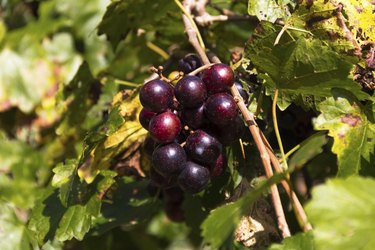
Whether deep red or greenish-bronze, the large, tough-skinned grapes known as muscadines are among the few that will survive the South's hot, humid summers. The various muscadine varieties, including the well-known bronze-hued scuppernong, thrive in wild areas, vineyards and home gardens. Because of this abundance, muscadines have been heavily used in Southern diets for more than just wine. In addition to being a sweet snack, muscadine grapes are also featured in classic recipes for entrees, desserts and preserves.
Fresh Fruit
Video of the Day
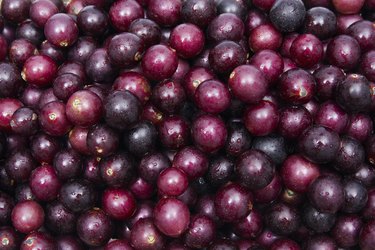
Most people prefer not to eat the thick skins or large seeds of the muscadine -- but that doesn't mean the Southern grapes don't make suitable fresh eating. After biting or slicing a small slit into the grape skin, hold the open end of the grape inside your mouth and pop the pulp from the skin by squeezing the grape with your fingers. Discard the skin and seeds, unless you have a hankering for the tough, yet edible pieces.
Video of the Day
Juicing up Recipes
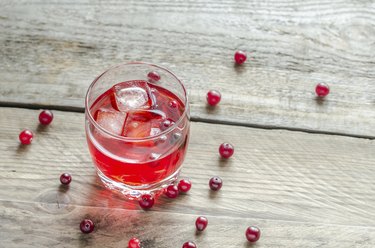
Coaxing the juice from muscadine grapes not only produces a tangy liquid to replace your usual fruit juice, but also forms the base of jellies, wines and iced desserts. To juice muscadine grapes, choose fruit that is ripe but not overly so, then wash and mash them. This pulp gets simmered in its own juices, for about 10 minutes, before being put through a strainer to express the juice. An overnight settling in the refrigerator, then a final straining through jelly bags or cheesecloth, will produce muscadine juice that you can use in jellies and other foods.
Southern-Style Jelly
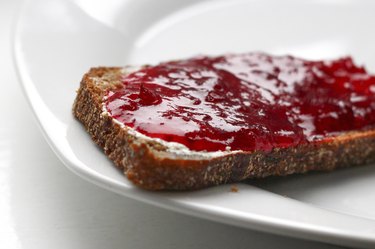
Muscadine jelly starts with the fresh juice, which is boiled rapidly with sugar at a rate of 4 parts muscadine juice to 3 parts sugar. When the temperature reaches about 220 degrees Fahrenheit, test the jelly by inserting a chilled spoon into the mixture and tipping the filled spoon on its side and letting the fluid drip back into the pan. If two drops come together as they are dripping from the spoon and form a "sheet," the muscadine jelly is ready to come off the heat and have its foam skimmed, says the National Center for Home Food Preservation. After filling and sealing jelly jars, they go into a boiling water canner for at least 5 minutes, depending on your altitude.
Sophisticated Slushies

To make an elegant granita -- an iced dessert somewhat similar to a sorbet -- start by simmering a few cups of muscadine juice with a small scoop of sugar. After the juice and sugar simmer for about 10 minutes, it's brought off the heat, and mixed with an equal amount of cold water. This mixture is then put in a glass dish, slipped into the freezer, and removed every 30 minutes or so for scraping and remixing to create an icy treat.
"Muscy" Muffins and More

To use muscadines in baked goods, you'll need to process the grapes first -- the fruit is too big and seedy to use in muffins or cakes as you might blueberries. After you've removed the pulp from the skins, heat the pulp to loosen the seeds. The pulp, put through a sieve to remove the seeds, can rejoin the skins until it becomes a tender filling. Once you have your pulpy filling, spread it over a basic cake batter before it goes into the oven, or use it as a muffin filling.
Tangy Touches
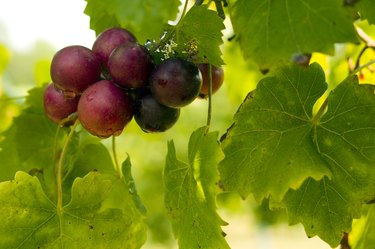
Along with their key role in desserts and preserves, muscadine grapes add piquancy to Southern savories. Once roasted or baked, the skins soften enough for easy chewing, making preparation limited to halving or quartering the grapes, and removing their seeds with the tip of a knife. Muscadines make a sweet-savory combination on feta-onion pizza, or when roasted with sausage, pork or lamb chops. Also on the non-sweet spectrum, muscadine juice forms the basis for a hearty vinegar when fermented with sugar, wine or grain alcohol, and for starter vinegars, such as apple cider.
- North Carolina Cooperative Extension: It's Time for Muscadines!
- Serious Eats: Cornmeal, Goat Cheese and Muscadine Pizza
- Epicurious: Scuppernong Vinegar
- University of Florida IFAS Extension: The Muscadine Grape
- Centers for Home Food Preservation: Muscadine or Scuppernong Jelly
- Coast to Coast: North Carolina Muscadine Dump Cake
- Evening Edge: Muscadine Muffins
- USDA: Muscadine Grapes: A New Health Food and an Alternative Crop